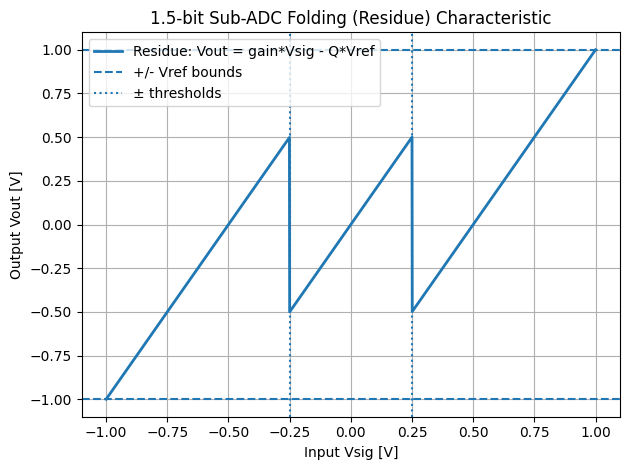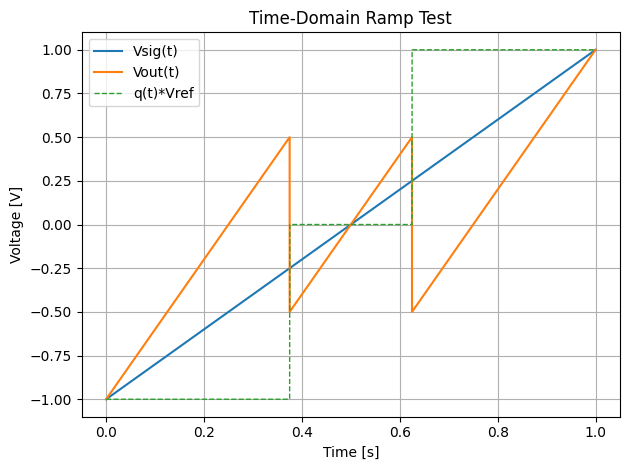1. 基本式(折り返し残差)
$$
V_{\text{out}} = 2V_{\text{sig}} - Q(V_{\text{sig}}),V_{\text{ref}}
$$
ここで
- $V_{\text{sig}}$:入力信号
- $V_{\text{ref}}$:基準電圧
- $Q(V_{\text{sig}}) \in {-1, 0, +1}$:量子化コード
2. 区間ごとの展開
(a) $V_{\text{sig}} < -\frac{V_{\text{ref}}}{4}$ のとき
このとき $Q = -1$。
$$
V_{\text{out}} = 2V_{\text{sig}} - (-1),V_{\text{ref}} = 2V_{\text{sig}} + V_{\text{ref}}
$$
- 出力は傾き 2 の直線で、入力が小さいほど大きく負方向に進む。
- ただしシフト $+V_{\text{ref}}$ があるため、$-V_{\text{ref}}$ で折り返す。
(b) $-\frac{V_{\text{ref}}}{4} \leq V_{\text{sig}} \leq +\frac{V_{\text{ref}}}{4}$ のとき
このとき $Q = 0$。
$$
V_{\text{out}} = 2V_{\text{sig}}
$$
- 原点を通る直線、傾きは 2。
- 入力がゼロのとき残差もゼロ。
(c) $V_{\text{sig}} > +\frac{V_{\text{ref}}}{4}$ のとき
このとき $Q = +1$。
$$
V_{\text{out}} = 2V_{\text{sig}} - V_{\text{ref}}
$$
- 出力は傾き 2 の直線だが、$-V_{\text{ref}}$ だけシフトされる。
- $,+V_{\text{ref}}$ で折り返す。
3. 全体のイメージ
- 各区間で 傾き = 2 の直線 だが、判定に応じて $\pm V_{\text{ref}}$ の補正が入る。
- その結果、入力範囲 $[-V_{\text{ref}}, +V_{\text{ref}}]$ を常に $[-V_{\text{ref}}, +V_{\text{ref}}]$ に収める折り返し波形 となる。
- 図の「ジグザグの青線」はこの式そのものを表している。
4. 最終まとめ
$$
V_{\text{out}} =
\begin{cases}
2V_{\text{sig}} + V_{\text{ref}}, & V_{\text{sig}} < -\tfrac{V_{\text{ref}}}{4} \
2V_{\text{sig}}, & -\tfrac{V_{\text{ref}}}{4} \leq V_{\text{sig}} \leq +\tfrac{V_{\text{ref}}}{4} \
2V_{\text{sig}} - V_{\text{ref}}, & V_{\text{sig}} > +\tfrac{V_{\text{ref}}}{4}
\end{cases}
$$
# Program Name: folding_1p5bit.py
# Creation Date: 20250821
# Overview: Simulate a 1.5-bit sub-ADC folding (residue) characteristic and plot Vout versus Vsig, plus a time-domain ramp test.
# Usage: Run this script as-is. Adjust parameters in the "User parameters" section to change Vref, gain, thresholds, sweep range, and ramp settings.
# If needed in notebooks like Colab, uncomment the next line:
# !pip install numpy matplotlib -q
import numpy as np
import matplotlib.pyplot as plt
# =========================
# User parameters / パラメータ一元管理
# =========================
Vref: float = 1.0 # Reference voltage [V] / 基準電圧[V]
gain: float = 2.0 # Interstage gain (folding slope) / 折り返し部の傾き(段間ゲイン)
th_ratio: float = 1.0/4.0 # Threshold ratio (±Vref/4) / しきい値の比率(±Vref/4)
vmin: float = -1.0 # Input sweep min normalized to Vref=1 / 入力最小(Vref=1基準)
vmax: float = 1.0 # Input sweep max normalized to Vref=1 / 入力最大(Vref=1基準)
Npts: int = 2001 # Number of sweep points / サンプル点数
show_grid: bool = True # Show grid or not / グリッド表示
linewidth_main: float = 2.0 # Plot line width / 線幅
# Ramp test parameters / ランプ波パラメータ(時間領域テスト)
T_ramp: float = 1.0 # Ramp duration [s] / ランプ継続時間
fs_time: float = 20000.0 # Time sampling rate [Hz] / 時間サンプリング周波数
include_q_trace: bool = True # Plot q*Vref in the time plot / 時間波形に q*Vref も表示
# =========================
# Derived values / 派生値
# =========================
Vth_pos: float = th_ratio * Vref # +threshold / 正のしきい値
Vth_neg: float = -th_ratio * Vref # -threshold / 負のしきい値
# =========================
# Quantizer & residue definitions / 量子化器と残差の定義
# =========================
def q_1p5bit(vsig: np.ndarray, vref: float, vth_pos: float, vth_neg: float) -> np.ndarray:
"""
1.5-bit 3-level quantizer: returns {-1, 0, +1}
1.5ビット3値量子化器:{-1, 0, +1} を返す
"""
q = np.zeros_like(vsig, dtype=np.int8)
q[vsig > vth_pos] = +1
q[vsig < vth_neg] = -1
return q
def residue(vsig: np.ndarray, vref: float, gain_: float, q: np.ndarray) -> np.ndarray:
"""
Folding residue: Vout = gain * Vsig - q * Vref
折り返し残差:Vout = ゲイン*入力 - 量子化コード*Vref
"""
return gain_ * vsig - q.astype(float) * vref
# =========================
# Sweep & compute / 掃引して計算(静特性)
# =========================
Vsig = np.linspace(vmin * Vref, vmax * Vref, Npts) # Input sweep / 入力掃引
Q = q_1p5bit(Vsig, Vref, Vth_pos, Vth_neg) # Quantized code / 量子化コード
Vout = residue(Vsig, Vref, gain, Q) # Residue output / 残差出力
# =========================
# Piecewise check (optional) / 区間ごとの検算(任意)
# =========================
# (a) Vsig < -Vref/4 -> Vout = 2*Vsig + Vref
# (b) -Vref/4 <= Vsig <= +Vref/4 -> Vout = 2*Vsig
# (c) Vsig > +Vref/4 -> Vout = 2*Vsig - Vref
# =========================
# Plot 1: Static residue characteristic / 静特性プロット
# =========================
plt.figure()
plt.plot(Vsig, Vout, linewidth=linewidth_main, label="Residue: Vout = gain*Vsig - Q*Vref")
plt.axhline(+Vref, linestyle="--", label="+/- Vref bounds")
plt.axhline(-Vref, linestyle="--")
plt.axvline(+Vth_pos, linestyle=":", label="± thresholds")
plt.axvline( Vth_neg, linestyle=":")
plt.title("1.5-bit Sub-ADC Folding (Residue) Characteristic")
plt.xlabel("Input Vsig [V]")
plt.ylabel("Output Vout [V]")
plt.legend(loc="best")
if show_grid:
plt.grid(True)
plt.tight_layout()
# =========================
# Time-domain ramp test / 入力ランプ波テスト(時間領域)
# =========================
# Create a single ramp from vmin*Vref to vmax*Vref over T_ramp seconds
t = np.arange(0.0, T_ramp, 1.0/fs_time)
Vsig_ramp = np.linspace(vmin * Vref, vmax * Vref, t.size)
Q_ramp = q_1p5bit(Vsig_ramp, Vref, Vth_pos, Vth_neg)
Vout_ramp = residue(Vsig_ramp, Vref, gain, Q_ramp)
plt.figure()
plt.plot(t, Vsig_ramp, linewidth=1.5, label="Vsig(t)")
plt.plot(t, Vout_ramp, linewidth=1.5, label="Vout(t)")
if include_q_trace:
plt.plot(t, Q_ramp.astype(float)*Vref, linewidth=1.0, linestyle="--", label="q(t)*Vref")
plt.title("Time-Domain Ramp Test")
plt.xlabel("Time [s]")
plt.ylabel("Voltage [V]")
plt.legend(loc="best")
if show_grid:
plt.grid(True)
plt.tight_layout()
plt.show()
# =========================
# Numeric sanity check prints / 数値チェック出力
# =========================
test_points = np.array([vmin*Vref, Vth_neg*1.1, 0.0, Vth_pos*1.1, vmax*Vref])
test_Q = q_1p5bit(test_points, Vref, Vth_pos, Vth_neg)
test_Vout = residue(test_points, Vref, gain, test_Q)
for v, q, r in zip(test_points, test_Q, test_Vout):
print(f"Vsig={v:+.4f} V, Q={int(q):+d}, Vout={r:+.4f} V")
# End of script

